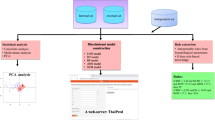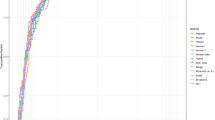Abstract
Pathogenesis of different diseases showed that some of them, especially thalassemia (T) and rheumatoid arthritis (RA) have an implicit association with oxidative stress and altered levels of reactive oxygen species (ROS). Introducing ROS level and the balance between ROS and antioxidants as essential metrics, an attempt was made to classify T and RA from normal individuals (treated as controls)(C) using synchronous fluorescence spectroscopy (SFS) and Raman line intensity of water. This non-invasive and label-free approach was backed up by a categorization algorithm that helped in the prediction of disease types from serum samples. The predictive system constituted principal component analysis (PCA) with four parameters, namely spectral intensity ratios of reduced nicotinamide adenine dinucleotide (NADH) to tryptophan (Trp) (NADH/Trp), kynurenine (Kyn) to tryptophan (Kyn/Trp), kynurenine to NADH (Kyn/NADH), and logarithmic changes in Raman line intensity of water (Rline), with the index headers containing the disease types. Rline has a positive correlation with both Kyn/Trp and Kyn/NADH and a negative correlation with NADH/Trp ratio, implying its direct or indirect association with oxidative stress. In addition to the classification of T, RA, and C a sub-classification of T into beta major and E-beta in their post and pre-splenectomized surgical stages could also be realized. Furthermore, receiver operating characteristic (ROC) analysis was deployed to ascertain that the misclassification error (ME) was negligible for the disease types.

A schematic representation of the workflow converging into the categorical classification of disease classes.







Similar content being viewed by others
References
Agresti A (2003) Categorical data analysis, vol 482. Wiley, New York
Badawy AAB (2017) Kynurenine pathway of tryptophan metabolism: regulatory and functional aspects. Int J Tryptophan Res. https://doi.org/10:1178646917691938
Baker A (2002) Fluorescence properties of some farm wastes: implications for water quality monitoring. Water Res 36(1):189–195
Borisova E, Gisbrecht A, Genova-Hristova T, Troyanova P, Pavlova E, Penkov N, Bratchenko I, Zakharov V, Lihachova I, Kuzmina I et al (2019) Multispectral autoflourescence detection of skin neoplasia using steady-state techniques. In: 20th International conference and school on quantum electronics: laser physics and applications, vol 11047. International Society for Optics and Photonics, p 1104704
Hoge FE, Swift RN (1981) Airborne simultaneous spectroscopic detection of laser-induced water raman backscatter and fluorescence from chlorophyll a and other naturally occurring pigments. Appl Optics 20(18):3197–3205
Ivanov AV, Valuev-Elliston VT, Tyurina DA, Ivanova ON, Kochetkov SN, Bartosch B, Isaguliants MG (2017) Oxidative stress, a trigger of hepatitis c and b virus-induced liver carcinogenesis. Oncotarget 8(3):3895
Lin W, Wu G, Li S, Weinberg EM, Kumthip K, Peng LF, Méndez-Navarro J, Chen W-C, Jilg N, Zhao H et al (2011) Hiv and hcv cooperatively promote hepatic fibrogenesis via induction of reactive oxygen species and nfκ b. J Biol Chem 286(4):2665– 2674
Mejía SÁ, Gutman LAB, Camarillo CO, Navarro RM, Becerra MCS, Santana LD, Pérez M C EH, Flores MD (2018) Nicotinamide prevents sweet beverage-induced hepatic steatosis in rats by regulating the g6pd, nadph/nadp+ and gsh/gssg ratios and reducing oxidative and inflammatory stress. Eur J Pharmacol 818:499–507
Modesto C, Anton J, Rodriguez B, Bou R, Arnal C, Ros J, Tena X, Rodrigo C, Rotes I, Hermosilla E et al (2010) Incidence and prevalence of juvenile idiopathic arthritis in Catalonia (Spain). Scand J Rheumatol 39(6):472–479
Pacheco ME, Bruzzone L (2013) Synchronous fluorescence spectrometry: conformational investigation or inner filter effect?. J Lumin 137:138–142
Pershin SM, Grishin MYa, Lednev VN, Garnov SV, Bukin VV, Chizhov PA, Khodasevich IA, Oshurko VB (2018) Quantification of distortion of the water oh-band using picosecond raman spectroscopy. Laser Phys Lett 15(3):035701
Phull A-R, Nasir B, ul Haq I, Kim SJ (2018) Oxidative stress, consequences and ros mediated cellular signaling in rheumatoid arthritis. Chemico-Biol Interact 281:121–136
Pootrakul P, Vongsmasa V, La-Ongpanich P, Wasi P (1981) Serum ferritin levels in thalassemias and the effect of splenectomy. Acta Haematol 66(4):244–250
Raja SO, Shaw J, Chattopadhyay A, Chatterjee S, Bhattacharya M, Dasgupta AK (2014) Synchronous fluorescence based one step optical method for assessing oxidative stress and its dependence on serum ferritin. Anal Methods 6(16):6228–6231
Risoluti R, Materazzi S, Sorrentino F, Maffei L, Caprari P (2016) Thermogravimetric analysis coupled with chemometrics as a powerful predictive tool for ß-thalassemia screening. Talanta 159:425–432
Rivella S (2009) Ineffective erythropoiesis and thalassemias. Curr Opin Hematol 16(3):187
Robertson MP, Caithness N, Villet MH (2001) A pca-based modelling technique for predicting environmental suitability for organisms from presence records. Divers Distrib 7(1–2):15–27
Rybka J, Kdziora-Kornatowska K, BanasLezanska P, Majsterek I, Carvalho LA, Cattaneo A, Anacker C, Kedziora J (2013) Interplay between the pro-oxidant and antioxidant systems and proinflammatory cytokine levels, in relation to iron metabolism and the erythron in depression. Free Radic Biol Med 63:187–194
Sas K, Szabó E, Vécsei L (2018) Mitochondria, oxidative stress and the kynurenine system, with a focus on ageing and neuroprotection. Molecules 23(1):191
Shaw J, Chakraborty A, Nag A, Chattopadyay A, Dasgupta AK, Bhattacharyya M (2017) Intracellular iron overload leading to dna damage of lymphocytes and immune dysfunction in thalassemia major patients. Eur J Haematol 99(5):399–408
Shaw J, Chakraborty A, Chatterjee S, Bhattacharyya M, Dasgupta AK (2018) Chelation therapy using static magnetic field. bioRxiv p 429597
Shipley B (2016) Cause and correlation in biology: a user’s guide to path analysis, structural equations and causal inference with R. Cambridge University Press, Cambridge
Sing T, Sander O, Beerenwinkel N, Lengauer T (2005) Rocr: visualizing classifier performance in r. Bioinformatics 21(20):3940–3941
Trott PA (1977) International classification of diseases for oncology. J Clin Pathol 30(8):782
Venepalli NK, Shergill A, Dorestani P, Boyd AD (2014) Conducting retrospective ontological clinical trials in icd-9-cm in the age of icd-10-cm. Cancer Inform 13:CIN–S14032
Vlahos R, Stambas J, Selemidis S (2012) Suppressing production of reactive oxygen species (ros) for influenza a virus therapy. Trends Pharmacol Sci 33(1):3–8
Wellens HLL, BeGole EA, Kuijpers-Jagtman AM (2017) Roc surface assessment of the anb angle and wits appraisal’?s diagnostic performance with a statistically derived ‘gold standard’: does normalizing measurements have any merit?. Eur J Orthod 39(4):358–364
Acknowledgements
We thank Calcutta Medical College from where all the blood samples were collected.
Funding
We thank the Indian Council of Medical Research (ICMR) Project file no. 5/3/8/322/2016 for funding this work.
Author information
Authors and Affiliations
Corresponding author
Additional information
Publisher’s note
Springer Nature remains neutral with regard to jurisdictional claims in published maps and institutional affiliations.
Electronic supplementary material
Below is the link to the electronic supplementary material.
Rights and permissions
About this article
Cite this article
Chakraborty, A., Chatterjee, S.K. & Dasgupta, A.K. Label-free detection of thalassemia and other ROS impairing diseases. Med Biol Eng Comput 58, 2143–2159 (2020). https://doi.org/10.1007/s11517-020-02191-z
Received:
Accepted:
Published:
Issue Date:
DOI: https://doi.org/10.1007/s11517-020-02191-z




